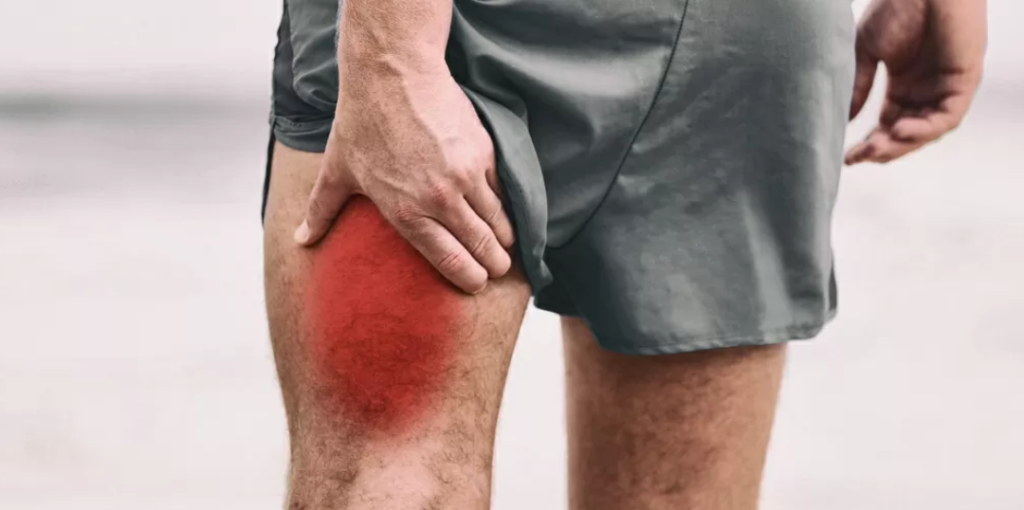
Physiotherapy And Exercise For Hamstring Strains
Hamstring strains are a common injury during the preseason in sports such as soccer and rugby. The biceps femoris muscle, one of four in the hamstring group, is the most commonly injured and accounts for 11% of all muscle strains.
The major reasons for hamstring injuries include the high eccentric (i.e. muscle contraction while the muscle is lengthening) demand during the second half of swing phase in sprinting, during the follow through when kicking, and accumulation of microtrauma when running loads increase beyond the ability for the athlete to recover.
Another reason why the biceps femoris is the most commonly strained hamstring muscle is because it is a two joint muscle (i.e. it crosses 2 joints, the hip and the knee). This predisposes it to greater stretch demands compared to single joint muscles. The shorter fascicle length of the long head of the biceps femoris also increase the risk of a strain.
Risk Factors For Tearing Your Hamstring
Risk factors increasing the likelihood of an acute hamstring strain include an acute spike in high-speed running volume and lack of previous exposure and kicking. Overuse strains occur typically due to a spike in general running load causing microtrauma resulting in a strain. Knee injuries can also increase the risk of a strain due to altered biomechanics post injury during running.
Pre-season training is a common time to pick up hamstring tears. This is because many recreational players have had a break from sport-specific hamstring loading (eg sprinting) in the off-season, and getting back into high-speed or high-volume running too quickly is a primary risk factor for hamstring tears.
Early Treatment For Hamstring Tears
Hamstring treatment initially involves resting the injury for 1-3 days to help minimise bleeding and prevent further damage to the muscle. Avoiding anti-inflammatories such as NSAIDs and ice (cryotherapy) is important because these can blunt the healing process and push back recovery. Using elevation and compression to minimise excessive swelling can be helpful.
Education about the stages of healing, the benefits of active therapy rather than passive treatments, load management and graded exposure to activity are important. Your physio will help you with this, and let you know what you should and shouldn’t be doing in terms of general daily activity in these early stages of healing.
Ongoing Treatment For Hamstring Tears
Progressive loading (strengthening) is then applied after the initial inflammatory phase. Loading promotes tissue repair and remodelling and builds load tolerance and capacity. It is essential to restore the full strength of your hamstrings to recover from your current injury, return to full sports performance, and also to reduce your risk of future tears.
Vascularisation via early movement (mobilisation) and aerobic-based activity promotes healing via increasing blood flow to the injured muscle. Lastly graded exposure to activities within the sport such as sprinting are important as returning without this exposure increases the likelihood of reinjury.
The exact combination of exercises, loading, cardio exercise and return-to-sport planning will vary depending on you, your degree of injury, past injury factors, type and level of sport you are returning to, and overall fitness. Our physio team are experienced in managing hamstring tears of all degrees and successfully returning you back to your sport.
Feel free to contact us for more info or to book your assessment.
Hamstring Strain Treatment References:
- Dubois, B., & Esculier, J. F. (2020). Soft-tissue injuries simply need PEACE and LOVE. British journal of sports medicine, 54(2), 72-73.
- Best, T. M. (1997). Soft-tissue injuries and muscle tears. Clinics in sports medicine, 16(3), 419-434.
- Hasselman, C. T., Best, T. M., Hughes IV, C., Martinez, S., & Garrett Jr, W. E. (1995). An explanation for various rectus femoris strain injuries using previously undescribed muscle architecture. The American Journal of Sports Medicine, 23(4), 493-499.
- Kary, J. M. (2010). Diagnosis and management of quadriceps strains and contusions. Current reviews in musculoskeletal medicine, 3(1), 26-31.
- Woods, C., Hawkins, R., Hulse, M., & Hodson, A. (2002). The Football Association Medical Research Programme: an audit of injuries in professional football—analysis of preseason injuries. British journal of sports medicine, 36(6), 436-441.

